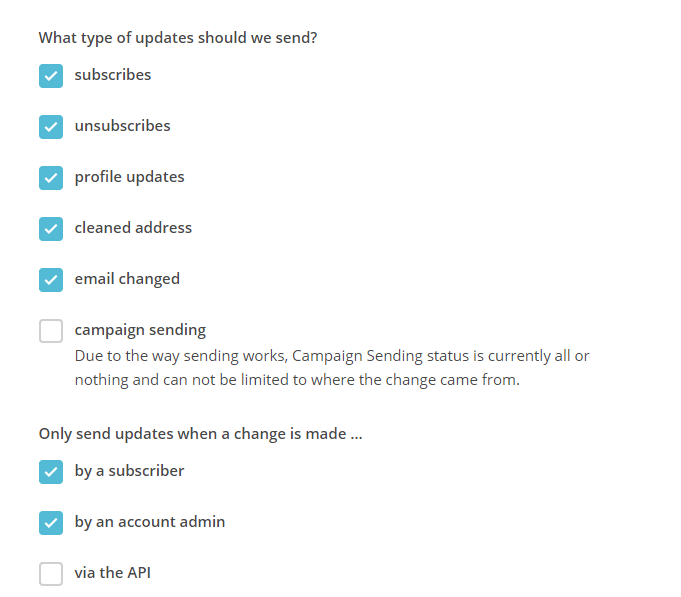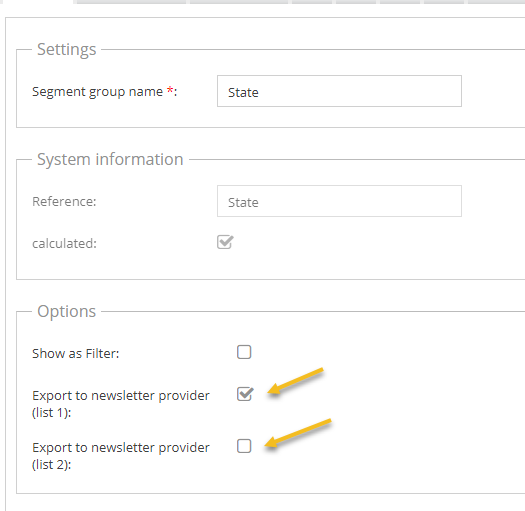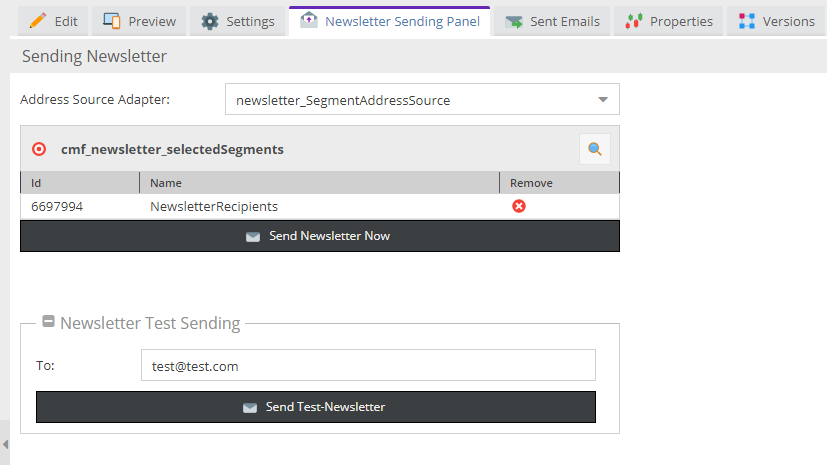MailChimp/Newsletter Sync
The CMF offers built-in support for synchronizing customer data with MailChimp. It synchronizes configured parts of the customer data and optionally also can export mail templates based on Pimcore mail documents.
Other newsletter systems could be integrated too by implementing the
NewsletterProviderHandlerInterface.
Configuration
The newsletter synchronisation has to be enabled in CMF configuration. Additional configurations are
newsletterQueueImmediateAsyncExecutionEnabled: customer is synchronized with MailChimp on every save.- MailChip API settings.
Further than that, the CMF can handle multiple MailChimp lists. Each list is one separate symfony service tagged with
cmf.newsletter_provider_handler.
See Configuration for an example configuration of such a service and for a list of general newsletter related settings.
See Multiple Mailchimp Accounts if you need to handle lists within different Mailchimp accounts.
Prepare Data Objects for MailChimp Sync
Customer
It's needed to add a newsletterStatus and mailchimpStatus field into the customer class for each MailChimp list:
The fields need to be named with the shortcut of the associated provider handler as a suffix (e.g. newsletterStatusList1
and mailchimpStatusList1).
The newsletter status is a project-specific setting. A mapping between the status options and the MailChimp status options need to be done in the service definition of the provider handler.
The MailChimp status needs to be a read only field with the following options:
subscribedunsubscribedpendingcleaned
If the MailChimp sync feature is enabled, the Customer data object class needs to implement the MailchimpAwareCustomerInterface.
This interface offers one method:
public function needsExportByNewsletterProviderHandler(NewsletterProviderHandlerInterface $newsletterProviderHandler);
This method could be used to decide, if a customer needs to be exported to a given MailChimp list (most of the time you will do this by the configured shortcut of the MailChimp provider handler). With this mechanism it's possible to create different lists with different customers based on some kind of rules.
CustomerSegmentGroup
Besides customers, also customer segments can be exported as interest groups to MailChimp. To configure that, add a checkbox
called exportNewsletterProvider{PROVIDER_HANDLER_SHORTCUT} for each list to the CustomerSegmentGroup class.
See below for more details.
Exporting Customers to MailChimp
Newsletter Queue
Exporting customer data to MailChimp is handled asynchronously. This means, that each time when a customer get's saved it will be added to the newsletter queue (represented by a database table).
A cronjob in the background, which should run every few minutes, then processes the queue items. If they were successfully processed, they will be removed from the queue.
If the sync does not work (e.g. because MailChimp does not respond properly, etc.) they stay in the queue and will be executed later on. See also CronJobs.
Immediate execution of export on customer save
Although the export is handled asynchronously it is possible to enable that a queue entry will be processed immediately after a customer is saved. This will still run as background task. The queue will be only triggered asynchronously exactly for the saved customer. If the export is not successful, the entry will stay in the queue.
The config option for this behaviour is called newsletterQueueImmediateAsyncExecutionEnabled
(see Configuration).
Webhook
The CMF offers a MailChimp webhook endpoint to receive updates from MailChimp. The webhook is implemented as webservice and is handled the same way as the REST webservice in the Pimcore core.
So the steps to enable the webhook are as following:
- Enable the Pimcore core webservice feature.
- Create a Pimcore user for handling the webhook (e.g. "mailchimp-webhook").
- Generate an api key for the Pimcore user.
- Add a webhook in the MailChimp web interface with the following URL:
https://mydomain.com/__customermanagementframework/webservice/mailchimp/webhook?apikey=53c5f6f3427545e712fe59ce043489f86ee0eb4b64a7c098d89d4288167eec1cThe webhook needs to be configured like this:


Caution: Pimcore should be the master data base. Therefore no changes of user data (e.g. interest groups) within MailChimp should be allowed. The CMF processes updates of simple merge fields but it's much better to disallow such updates. Customer segments/interest groups definitely can not be synced back to Pimcore.
Cronjob for syncing data from MailChimp to Pimcore
The webhook makes it possible that updates in MailChimp are synced in more or less real time to Pimcore. But sometimes this might not work (for example when the server is down). Therefore the CMF offers an additional cronjob, which could run once a day and synchronize needed updates to Pimcore. See also CronJobs - Mailchimp status sync.
Exporting CustomerSegments to MailChimp
Customer segment exports are handled by the newsletter queue too (see above). MailChimp has a limit of 60 interest groups (the equivalent for CustomerSegments in MailChimp) per list. Therefore the CMF offers a configuration option for what CustomerSegmentGroups should be exported (all segments within this group will be exported).
It's necessary to add a checkbox exportNewsletter{PROVIDER_HANDLER_SHORTCUT} for each provider handler (mailchimp list)
into the CustomersSegmentGroup data objects.
Exporting newsletter templates to MailChimp
As soon as the newsletter sync is enabled, a "Export Template to MailChimp" button will appear in email documents:
With this it's possible to create the newsletter within Pimcore and then use it for emailing campaigns within MailChimp.
Logging
The CMF logs MailChimp sync related changes on three different levels:
- Customer activities are tracked on each MailChimp status change
- In the notes and events tab of the customer a list of successful exports will be shown.
- Errors are logged into the application logger.
Addressing a customer segment with Pimcore's own newsletter functionality
The CMF comes equipped with its own address source adapter, selectable from the Newsletter Sending Panel in newsletter documents.
Here multiple customer segments can be selected to send a newsletter to all customers related to any of them. For this adapter to become available it must be configured as shown in the example below:
pimcore:
newsletter:
source_adapters:
SegmentAddressSource: cmf.document.newsletter.factory.segmentAddressSource



